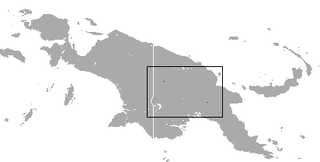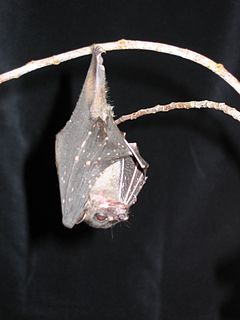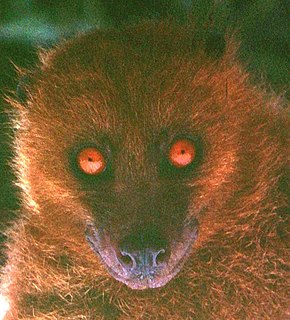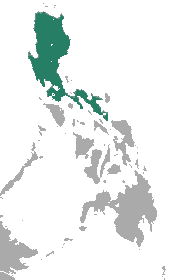 W
WMegabats constitute the family Pteropodidae of the order Chiroptera (bats). They are also called fruit bats, Old World fruit bats, or—especially the genera Acerodon and Pteropus—flying foxes. They are the only member of the superfamily Pteropodoidea, which is one of two superfamilies in the suborder Yinpterochiroptera. Internal divisions of Pteropodidae have varied since subfamilies were first proposed in 1917. From three subfamilies in the 1917 classification, six are now recognized, along with various tribes. As of 2018, 197 species of megabat had been described.
 W
WThe Mindanao pygmy fruit bat is a species of megabat in the family Pteropodidae. It is monotypic within the genus Alionycteris. It is endemic to the Philippines. Its natural habitat is subtropical or tropical dry forests. It is threatened by habitat loss. It is a high-elevation specialist which is either scarce or overtaken by tourist hotspots. As a result, this species may be seeking new elevated habitats likely in the southern region of the Philippines and along the islands of Sulawesi as well.
 W
WBulmer's fruit bat is a megabat endemic to New Guinea. It is listed as a critically endangered species due to habitat loss and hunting. It is the only member of the genus Aproteles. Due to its imperiled status, it is identified by the Alliance for Zero Extinction as a species in danger of imminent extinction.
 W
WThe spotted-winged fruit bat, is the smallest megabat in the world, and the only species in the genus Balionycteris. It inhabits forests in Indonesia and Malaysia.
 W
WThe black-capped fruit bat is a species of megabat in the monotypic genus Chironax.
 W
WBlanford's fruit bat is a mountain species of megabat. It is found in several countries in South and Southeast Asia.
 W
WThe Manado fruit bat is a species of megabat in the family Pteropodidae.
 W
WBulmer's fruit bat is a megabat endemic to New Guinea. It is listed as a critically endangered species due to habitat loss and hunting. It is the only member of the genus Aproteles. Due to its imperiled status, it is identified by the Alliance for Zero Extinction as a species in danger of imminent extinction.
 W
WThe black-capped fruit bat is a species of megabat in the monotypic genus Chironax.
 W
WD'Anchieta's fruit bat is a species of megabat in the family Pteropodidae. It is the only species in the genus Plerotes. It is found in Angola, Democratic Republic of the Congo, Malawi, and Zambia, where it lives in subtropical or tropical dry forests, dry savanna, and moist savanna. It is listed as Data Deficient on the IUCN Red List. The scientific and common names for the species commemorate José Alberto de Oliveira Anchieta, who is also honoured in the names of Anchieta's Pipistrelle and the Angolan Vlei Rat. It was described in 1900 by Antero Frederico de Seabra, under the name Epomorphus anchietae.
 W
WThe dusky fruit bat, is a species of bat found in Indonesia and Malaysia.
 W
WEpomophorinae is a subfamily of megabat. It was established as a subfamily in 1997. Epomophorine bats are found only in Africa.
 W
WThe Fijian monkey-faced bat or Fijian flying fox is a megabat endemic to Fiji. It was discovered in old-growth cloud forest on Des Vœux Peak, the second highest mountain peak on the island of Taveuni by William and Ruth Beckon in 1976, and is Fiji's only endemic mammal. It has recently been transferred from Pteralopex to its own monotypic genus Mirimiri.
 W
WThe Fischer's pygmy fruit bat or Philippine pygmy fruit bat is a species of megabat in the family Pteropodidae. It is monotypic within the genus Haplonycteris. It is endemic to the Philippines. Its natural habitat is subtropical or tropical dry forests. It is threatened by habitat loss.
 W
WMegabats constitute the family Pteropodidae of the order Chiroptera (bats). They are also called fruit bats, Old World fruit bats, or—especially the genera Acerodon and Pteropus—flying foxes. They are the only member of the superfamily Pteropodoidea, which is one of two superfamilies in the suborder Yinpterochiroptera. Internal divisions of Pteropodidae have varied since subfamilies were first proposed in 1917. From three subfamilies in the 1917 classification, six are now recognized, along with various tribes. As of 2018, 197 species of megabat had been described.
 W
WThe hammer-headed bat, also known as hammer-headed fruit bat and big-lipped bat, is a megabat widely distributed in West and Central Africa. It is the only member of the genus Hypsignathus, which is part of the tribe Epomophorini along with four other genera. It is the largest bat in continental Africa, with wingspans approaching 1 m, or about 3 ft, and males almost twice as heavy as females. Males and females also greatly differ in appearance, making it the most sexually dimorphic bat species in the world. These differences include several adaptations that help males produce and amplify vocalizations: the males' larynges are about three times as large as those of females, and they have large resonating chambers on their faces. Females appear more like a typical megabat, with foxlike faces.
 W
WThe Fischer's pygmy fruit bat or Philippine pygmy fruit bat is a species of megabat in the family Pteropodidae. It is monotypic within the genus Haplonycteris. It is endemic to the Philippines. Its natural habitat is subtropical or tropical dry forests. It is threatened by habitat loss.
 W
WThe hammer-headed bat, also known as hammer-headed fruit bat and big-lipped bat, is a megabat widely distributed in West and Central Africa. It is the only member of the genus Hypsignathus, which is part of the tribe Epomophorini along with four other genera. It is the largest bat in continental Africa, with wingspans approaching 1 m, or about 3 ft, and males almost twice as heavy as females. Males and females also greatly differ in appearance, making it the most sexually dimorphic bat species in the world. These differences include several adaptations that help males produce and amplify vocalizations: the males' larynges are about three times as large as those of females, and they have large resonating chambers on their faces. Females appear more like a typical megabat, with foxlike faces.
 W
WSalim Ali's fruit bat is a rare megabat species in the monotypic genus Latidens.
 W
WThe Luzon fruit bat is a species of megabat in the family Pteropodidae. It is monotypic within the genus Otopteropus. It is endemic to the Philippines. Its natural habitat is subtropical or tropical dry forest. It is threatened by habitat loss.
 W
WThe megabat tribe Macroglossini is within the subfamily Pteropodinae
 W
WMegaloglossus is a genus of bats in the family Pteropodidae. It is native to Africa. It contains two species, Megaloglossus azagnyi and Megaloglossus woermanni. Prior to 2012, it was considered a monotypic genus. In 2012, however, M. woermanni was split into two species with the description of M. azagnyi. It was described as a new species in 2012.
 W
WThe Mindanao pygmy fruit bat is a species of megabat in the family Pteropodidae. It is monotypic within the genus Alionycteris. It is endemic to the Philippines. Its natural habitat is subtropical or tropical dry forests. It is threatened by habitat loss. It is a high-elevation specialist which is either scarce or overtaken by tourist hotspots. As a result, this species may be seeking new elevated habitats likely in the southern region of the Philippines and along the islands of Sulawesi as well.
 W
WThe Fijian monkey-faced bat or Fijian flying fox is a megabat endemic to Fiji. It was discovered in old-growth cloud forest on Des Vœux Peak, the second highest mountain peak on the island of Taveuni by William and Ruth Beckon in 1976, and is Fiji's only endemic mammal. It has recently been transferred from Pteralopex to its own monotypic genus Mirimiri.
 W
WVeldkamp's dwarf epauletted fruit bat is a species of bat in the family Pteropodidae. It is monotypic within the genus Nanonycteris. It is found in Benin, Cameroon, Central African Republic, Ivory Coast, Ghana, Guinea, Liberia, Nigeria, Sierra Leone, and Togo. Its natural habitats are subtropical or tropical moist lowland forest, subtropical or tropical mangrove forest, subtropical or tropical moist montane forest, dry savanna, and moist savanna. It is threatened by habitat loss.
 W
WThe Luzon fruit bat is a species of megabat in the family Pteropodidae. It is monotypic within the genus Otopteropus. It is endemic to the Philippines. Its natural habitat is subtropical or tropical dry forest. It is threatened by habitat loss.
 W
WThe dusky fruit bat, is a species of bat found in Indonesia and Malaysia.
 W
WD'Anchieta's fruit bat is a species of megabat in the family Pteropodidae. It is the only species in the genus Plerotes. It is found in Angola, Democratic Republic of the Congo, Malawi, and Zambia, where it lives in subtropical or tropical dry forests, dry savanna, and moist savanna. It is listed as Data Deficient on the IUCN Red List. The scientific and common names for the species commemorate José Alberto de Oliveira Anchieta, who is also honoured in the names of Anchieta's Pipistrelle and the Angolan Vlei Rat. It was described in 1900 by Antero Frederico de Seabra, under the name Epomorphus anchietae.
 W
WThe Pteropodinae are a subfamily of megabats. Taxa within this subfamily are:Genus Acerodon Sulawesi flying fox, A. celebensis Talaud flying fox, A. humilis Giant golden-crowned flying fox, A. jubatus Palawan fruit bat, A. leucotis Sunda flying fox, A. mackloti Genus Desmalopex White-winged flying fox, D. leucopterus Small white-winged flying fox, D. microleucopterus Genus Eidolon — straw-coloured fruit bats Madagascan fruit bat, E. dupreanum Straw-coloured fruit bat, E. helvum Genus Mirimiri Fijian monkey-faced bat, M. acrodonta Genus Neopteryx Small-toothed fruit bat, N. frosti Genus Pteralopex Bougainville monkey-faced bat, P. anceps Guadalcanal monkey-faced bat, P. atrata Greater monkey-faced bat, P. flanneryi Montane monkey-faced bat, P. pulchra New Georgian monkey-faced bat, P. taki Genus Pteropus — flying foxes P. alecto species group Black flying fox, P. alecto P. caniceps species group Ashy-headed flying fox, P. caniceps P. chrysoproctus species group Silvery flying fox, P. argentatus Moluccan flying fox, P. chrysoproctus Makira flying fox, P. cognatus Banks flying fox, P. fundatus Solomons flying fox, P. rayneri Rennell flying fox, P. rennelli P. conspicillatus species group Spectacled flying fox, P. conspicillatus Ceram fruit bat, P. ocularis P. livingstonii species group Aru flying fox, P. aruensis Kei flying fox, P. keyensis Livingstone's fruit bat, P. livingstonii Black-bearded flying fox, P. melanopogon P. mariannus species group Okinawa flying fox, P. loochoensis Mariana fruit bat, P. mariannus Pelew flying fox, P. pelewensis Kosrae flying fox, P. ualanus Yap flying fox, P. yapensis P. melanotus species group Black-eared flying fox, P. melanotus P. molossinus species group Lombok flying fox, P. lombocensis Caroline flying fox, P. molossinus Rodrigues flying fox, P. rodricensis P. neohibernicus species group Great flying fox, P. neohibernicus P. niger species group Aldabra flying fox, P. aldabrensis Mauritian flying fox, P. niger Madagascan flying fox, P. rufus Seychelles fruit bat, P. seychellensis Pemba flying fox, P. voeltzkowi P. personatus species group Bismark masked flying fox, P. capistratus Masked flying fox, Pteropus personatus Temminck's flying fox, P. temminckii P. poliocephalus species group Big-eared flying fox, P. macrotis Geelvink Bay flying fox, P. pohlei Grey-headed flying fox, P. poliocephalus P. pselaphon species group Chuuk flying fox, P. insularis Temotu flying fox, P. nitendiensis Large Palau flying fox, P. pilosus Bonin flying fox, P. pselaphon Guam flying fox, P. tokudae Insular flying fox, P. tonganus Vanikoro flying fox, P. tuberculatus New Caledonia flying fox, P. vetulus P. samoensis species group Vanuatu flying fox, P. anetianus Samoa flying fox, P. samoensis P. scapulatus species group Gilliard's flying fox, P. gilliardorum Lesser flying fox, P. mahaganus Little red flying fox, P. scapulatus Dwarf flying fox, P. woodfordi P. subniger species group Admiralty flying fox, P. admiralitatum Dusky flying fox, P. brunneus Ryukyu flying fox, P. dasymallus Nicobar flying fox, P. faunulus Gray flying fox, P. griseus Ontong Java flying fox, P. howensis Small flying fox, P. hypomelanus Ornate flying fox, P. ornatus Little golden-mantled flying fox, P. pumilus Philippine gray flying fox, P. speciosus Small Mauritian flying fox, P. subniger P. vampyrus species group Indian flying fox, P. giganteus Andersen's flying fox, P. intermedius Lyle's flying fox, P. lylei Large flying fox, P. vampyrus incertae sedis Small Samoan flying fox, P. allenorum Large Samoan flying fox, P. coxi Genus Styloctenium Mindoro stripe-faced fruit bat, S. mindorensis Sulawesi stripe-faced fruit bat, S. wallacei
 W
WThe Rousettinae are a subfamily of megabats. Taxa within this subfamily include:
 W
WThe small-toothed fruit bat is a species of megabat in the family Pteropodidae. It is monotypic within the genus Neopteryx.
 W
WBlanford's fruit bat is a mountain species of megabat. It is found in several countries in South and Southeast Asia.
 W
WThe spotted-winged fruit bat, is the smallest megabat in the world, and the only species in the genus Balionycteris. It inhabits forests in Indonesia and Malaysia.
 W
WThe swift fruit bat is a species of megabat in the family Pteropodidae.
 W
WVeldkamp's dwarf epauletted fruit bat is a species of bat in the family Pteropodidae. It is monotypic within the genus Nanonycteris. It is found in Benin, Cameroon, Central African Republic, Ivory Coast, Ghana, Guinea, Liberia, Nigeria, Sierra Leone, and Togo. Its natural habitats are subtropical or tropical moist lowland forest, subtropical or tropical mangrove forest, subtropical or tropical moist montane forest, dry savanna, and moist savanna. It is threatened by habitat loss.
 W
WWoermann's bat or Woermann's fruit bat is a species of megabat in the family Pteropodidae. It is monotypic within the genus Megaloglossus. It is found in Angola, Benin, Cameroon, Central African Republic, Republic of the Congo, Democratic Republic of the Congo, Ivory Coast, Equatorial Guinea, Gabon, Ghana, Guinea, Liberia, Nigeria, Sierra Leone, Togo, and Uganda. Its natural habitats are subtropical or tropical moist lowland forests and moist savanna. It is threatened by habitat loss.